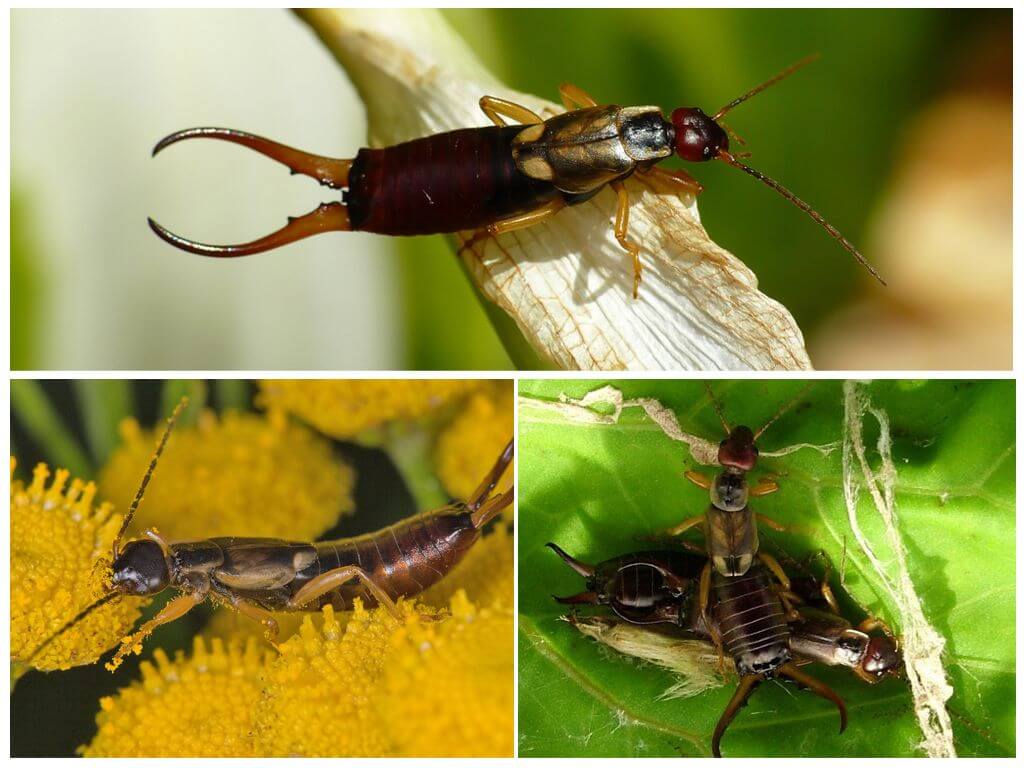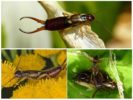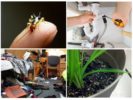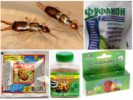- Earwig
- Pest Management
- Earwig Chemicals
Date in your life earwig accounted for many gardeners lovers. Awesome looking insects prefer to live in a humid environment. They settle in the neighborhood of agricultural land and summer cottages, causing great damage to cultural plantings. Therefore, it will not be amiss to know how to get rid of earwigs in a private house, garden or vegetable garden.
Features
Quite often, earwigs are called two-tail. However, these are completely different insects: the two-tails are representatives of the order of the maxillofacial hexapods, the earwig belongs to the order of the winged-winged animals. The presence of characteristic “tongs” located at the end of the abdomen generalizes these creatures. A photo and description of the earwig are presented below.
Earwig - an insect that is the owner of an elongated body:
- sizes vary from 1.5 to 2.5 cm, but there are also specimens reaching 8 cm;
- brown body consists of several segments;
- on a heart-shaped head there are long whiskers and very small eyes;
- there is a pronotum between the head and the body.
Earwigs have wings: the anterior ones are short and without venation, the posterior ones are larger, have radially located veins. However, their insect uses rarely enough, preferring to move on the ground.
Interesting!
The abdomen ends with tserkami - rigid appendages resembling ticks or tongs, which is why the pest is called a "pinch". With their help, an insect can not only retain food, but also defend itself.
Reasons for the appearance

The question of where the earrings come from is puzzled not only gardeners, but also residents of high-rise buildings. At the cottage pests attracted by the abundance of food, which is freely available. Often earwigs appear in the house along with fruits, vegetables or a festive bouquet of flowers brought. These creatures can easily take root if the room is damp. In high-rise apartment buildings, pinch bits come from damp basements, penetrating through cracks and cracks.
Is it dangerous?
Many people are interested in the danger of earwig. In the garden, it harms ornamental plants, damaging their leaves, eats shoots and nibbles flowers. He especially likes dahlias, poppies, asters and phlox. The presence of garden pests in the house causes not only disgust among its inhabitants.
On a note!
In case of accidental contact, the pest is able to bite. However, the assertion that the tweezers during the bite emit a toxic substance that can cause human death is a myth. Insects really secrete a liquid with a sharp specific odor. However, it is intended to deter the enemy.
In addition, adults may not feel a bite, but in children it can cause pain. As a result, in a person suffering from allergies, the damaged area may turn red and swell, often swelling and blisters appear. Therefore, having discovered double-tailed insects in the house, urgent measures must be taken to combat them.
We rid the house of pests

In private homes, earwigs are much more common than in apartments. After all, pests can easily enter the house from the garden. In addition, in private buildings there are more damp rooms.
- Before you begin to deal with earwigs in a private house, you need to get rid of the existing blockages and dry the damp rooms, checking all the drain pipes for leaks.
- Indoor plants growing in the house should not be ignored, because often insects live in their excessively moist soil.
- To get rid of earwigs in an apartment or a house, it is necessary to limit the path of their penetration by closing all cracks and crevices, as well as using mosquito nets on the windows.
- You can choose an effective remedy for earwigs in the sanitary and epidemiological station. Usually used ready-made poison or in the form of baits based on yolk and bran.
- Boric acid will also help to quickly get rid of pests in the house. It can be scattered on the floor or balls formed by mixing with egg yolk. The use of this method requires restricting the access of insects to water. Otherwise, a positive result will not succeed.
- You can also poison the tweezers with the help of the famous chalk Mashenka. They rub all the baseboards in the house or apartment, and also apply the tool in places where insects appear.
We rid the garden of pests

You can get rid of earwigs in the garden without harm to the crop in the following ways.
- To free a garden or garden from woodlice and earwig, it is necessary first of all to restore order in it. You should get rid of damp places littered with various wastes, as well as compost heaps and dumped trees. After all, it is there that pests most often live.
- The fight against earwigs will be effective even with a deep digging of the land in late autumn.
- You can destroy earwigs with a trap. It uses a richly dampened rag, a used tin can, or an old watering hose. Finding tweezers under a particular object, they should be poured with boiling water.
- Effectively poison earwigs with poisons. Fufaon, Intavir or Spark can be used to spray infected plantings. Biopreparations such as Lepidocide or Bitoxibacillin give a good result.
- Earwigs can be removed and folk remedies. To do this, many use the method of scaring away plants that have insecticidal properties. Wormwood, yarrow, tansy or basil are what the earwigs are afraid of. They make a tincture of them, in which laundry detergent or laundry soap is added. Such a solution is used to treat damaged plants.
About the benefits
However, not all reviews of tweezers are negative. Finding an insect in a garden or garden, do not rush to destroy it. In single quantities, the pest does not pose a great threat to plants. And vice versa: it’s a destroyer, caterpillars, spider mites, fliesslugs and aphids. Earwigs should be fought when their number becomes excessively large.







Such double-tailed individuals are also found in our garden. Maybe someone will tell you the most effective method of dealing with these creatures.
Once such a pinch even bit me. Moreover, her bite was rather painful.
Once, a family of earwigs was discovered in his bath. So I beat them all with boiling water and immediately. Not yet visible.
I prefer chemistry, despite the toxic composition. Dichlorvos, Thiuram or Fosbecid is the fastest and best option.
So that the pests do not damage the plants, their trunks are lubricated with ordinary medical petroleum jelly.